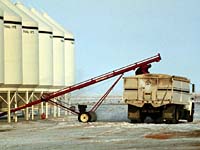
Storage and
Handling of Grain
The farmer's calendar is filled with activity throughout the year. As the summer passes, crops ripen and preparation takes place for the storage of grain. Grain bins are checked and deliveries to the elevator begin as early as July. Swathing and fall planting typically occurs in August, while combining, drying grain and the delivery of grain to the elevator occupies the month of September.
The quality of the grain that goes into storage is important and it is the harvesting of the grain which has an affect on this quality. Proper adjustments combine parts helps to minimize breakage, stress cracks or crushed seeds.
Producers monitor a condition called heating, which may occur to grain in storage. Heating causes most of the spoilage of stored grain. Damp, warm grain undergoes a higher rate of cellular respiration which releases heat. The moisture can also attract mite, mould
and insect populations. These organisms feed
on seeds, creating hot spots as they release
heat. Hot spots or hot pockets in the stored grain will often
cause seeds to stick together. If seeds are
close to the surface, they may begin to sprout.
Drying the grain prior to storage helps to alleviate the problem. Dryers which use air heated to
38 to 43°C, enable grain to be dried to acceptable levels before storage. The grain is cooled before being stored. Natural air drying uses outside air which is forced through a perforated floor beneath the grain. The moving air gradually removes excess moisture. Bins can be purchased which have built-in aeration units.
The control of insects in stored grain is important and numerous methods can be employed to prevent grain damage. One method is the
use of chemicals; bins are cleaned after use and insecticides are applyed to the bin. Grain which is already
infested can be treated with recommended liquid or dust insecticides
which may be applied as grain is being moved through an auger. Another method involves treating grain organically.
| 